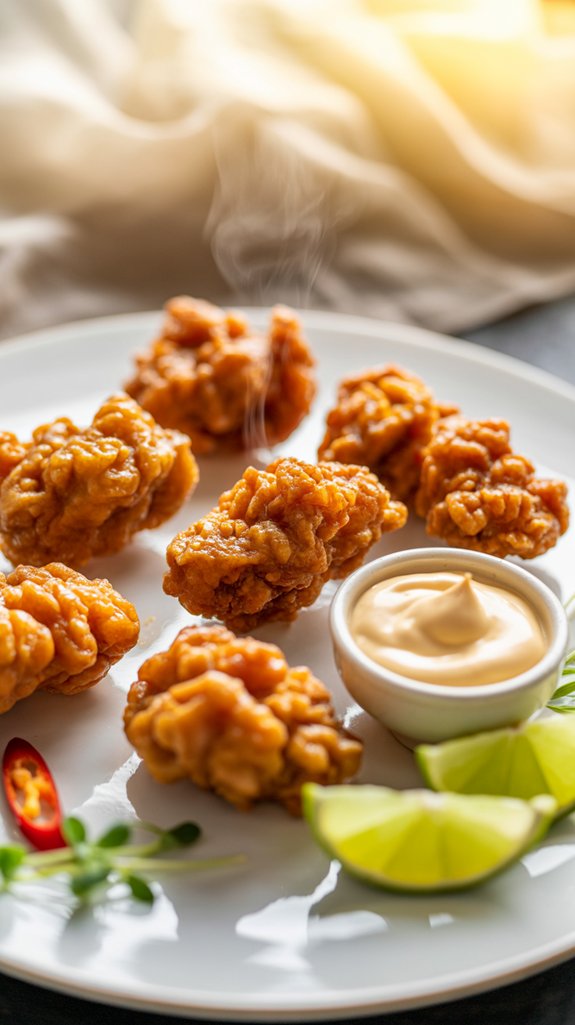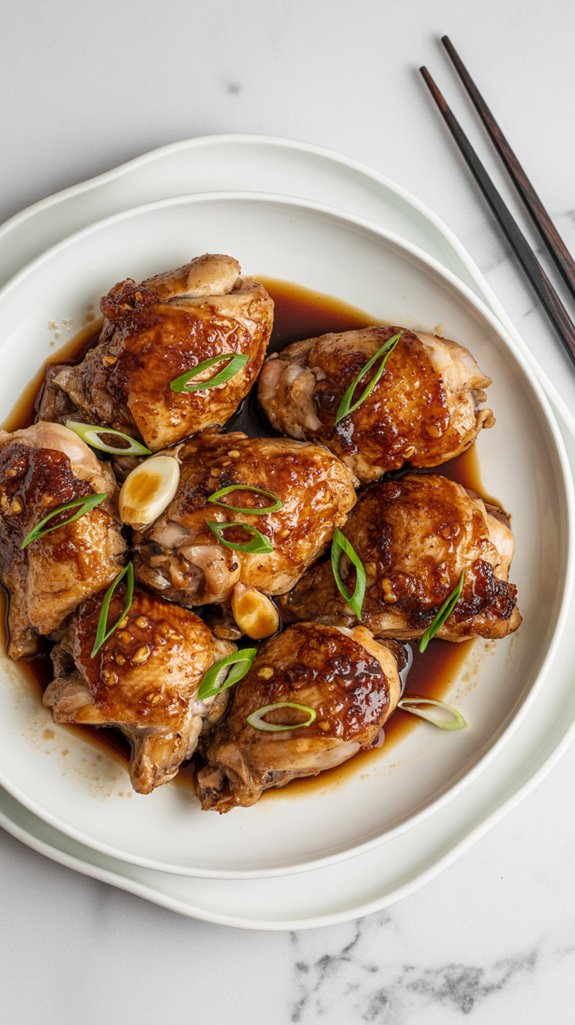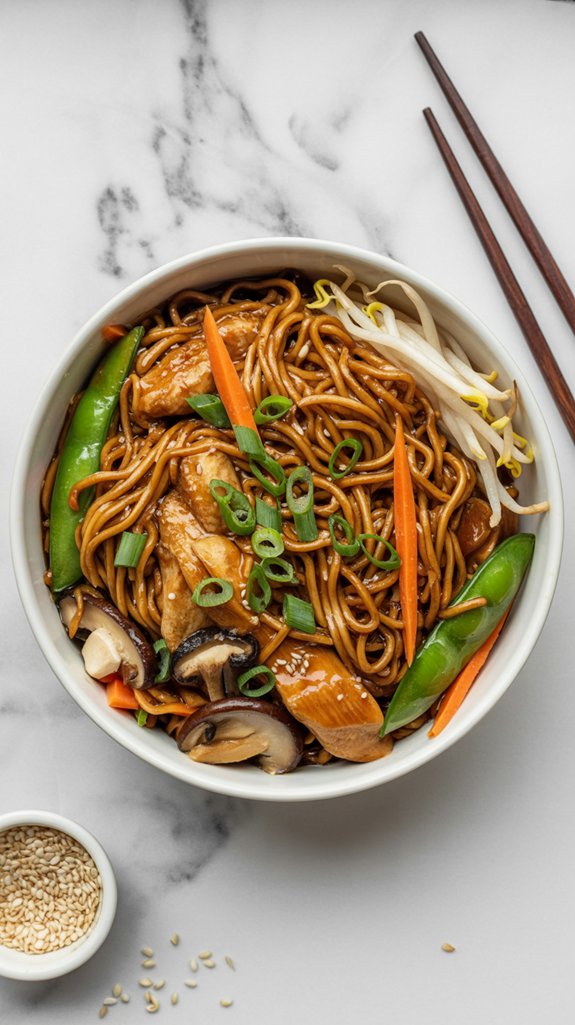Why You’ll Love This this Crispy Japanese Karaage
This Japanese karaage delivers that perfect crispy-on-the-outside, juicy-on-the-inside bite that makes you wonder why you ever settled for regular chicken nuggets.
The soy sauce and ginger marinade works its magic for just one hour, which means you’re not waiting around all day like some recipes that demand your patience and your firstborn.
That double-flour coating trick creates an extra-crunchy shell that stays crispy even after it cools down, and honestly, who doesn’t need that kind of reliability in their life.
Ingredients List
Getting your karaage game right starts with gathering these simple ingredients that pack a serious flavor punch.
- 2-4 boneless chicken breasts
- 1/2 cup soy sauce
- 3 tablespoons grated gingerroot
- 4 crushed garlic cloves
- Salt (to taste)
- Pepper (to taste)
- Cornflour
- White flour
- Vegetable oil
Health-wise, this recipe brings some solid wins to the table:
- Fresh ginger and garlic deliver natural anti-inflammatory benefits and immune-boosting properties
- You control the salt content, unlike store-bought nuggets that are basically sodium bombs
- The double-flour coating means you’re getting more crispy surface area per bite, so you might actually feel satisfied with smaller portions
- Vegetable oil for frying keeps it lighter than lard or heavy oils, though let’s be real, we’re still talking about fried chicken here
Step by Step Directions

Making authentic Japanese karaage requires proper marination and a double-coating technique for maximum crispiness.
- Cut 2-4 boneless chicken breasts into large, bite-sized pieces and place in a zip-top bag or bowl.
- Combine 1/2 cup soy sauce, 3 tablespoons grated ginger, 4 crushed garlic cloves, salt, and pepper.
- Pour marinade over chicken, mix thoroughly to coat all pieces, and refrigerate for 1 hour.
- Mix equal parts cornflour and white flour in a medium bowl.
- Remove marinated chicken and coat each piece in the flour mixture.
- Dip chicken in flour mixture a second time for extra crispiness.
- Heat vegetable oil to 350°F in deep fryer or fill deep skillet with 1 inch of oil on high heat.
- For deep fryer: Fry nuggets until golden brown, about 5 minutes.
- For skillet: Fry 2 minutes per side, turning with tongs when bottom is golden brown.
- Remove finished nuggets to paper towel-lined plate to drain excess oil.
- Repeat frying process until all chicken is cooked.
- Serve immediately with lemon slice if desired.
Use a premium thermometer to ensure your chicken reaches the safe internal temperature of 165°F for perfectly cooked karaage every time.
Substitutions and Variations
• Buttermilk twist – Some cooks swear by adding a splash of buttermilk to the marinade, which makes the chicken incredibly tender.
It’s not traditional, but sometimes tradition needs a little nudge, right?
• Size matters – Cut your pieces smaller for party appetizers, or leave them larger for a proper dinner portion.
Just remember that cooking times will vary, so keep those eagle eyes on the oil.
Additional Things to Serve With This Dish
Karaage plays well with others, which is honestly a relief because who wants to eat fried chicken all by itself like some kind of culinary hermit.
- Japanese mayo and rice – The classic combo that never fails. That creamy, slightly sweet Japanese mayo is basically karaage’s best friend, and a bowl of steamed rice soaks up all the good stuff.
- Pickled vegetables – Cucumber pickles or quick-pickled cabbage cut through all that crispy, fatty goodness like a palate-cleansing superhero.
- Ramen or udon soup – Drop a few pieces right into your noodle bowl because apparently some genius figured out that fried chicken makes everything better, even soup.
- Simple salad with sesame dressing – Something green and crunchy to balance out the fact that you’re basically eating crispy chicken candy.
- Beer or green tea – Cold beer if you’re feeling festive, hot green tea if you want to pretend you’re being sophisticated about your fried food choices.
- Edamame – Those little green pods give your hands something to do between chicken pieces, plus you get to feel slightly virtuous about eating vegetables.
Cooking Tips & Tricks (Chef’s Notes)
Making perfect karaage isn’t rocket science, but a few insider tricks will save you from serving up soggy disappointments or charcoal nuggets.
- Double-dip that chicken – One coating of flour is for amateurs, two coatings create that signature crunch that makes your teeth happy.
- Don’t skip the marinating time – Those flavors need at least an hour to actually penetrate the meat, not just sit on the surface like awkward party guests.
- Keep your oil temperature steady – Too hot and you’ll get burnt outsides with raw centers, too cool and you’ll end up with greasy sponges instead of crispy nuggets.
- Work in small batches – Cramming too many pieces in the pan drops the oil temperature faster than your enthusiasm on Monday morning.
- Pat the chicken dry before flouring – Excess marinade creates clumpy flour spots that look about as appetizing as wet concrete.
- Use a thermometer if you have one – Guessing oil temperature is like playing culinary roulette, and nobody wants to explain to their guests why dinner tastes like burnt regret.
- Let the cooked pieces rest on paper towels – This isn’t the time to be stingy with paper products, unless you enjoy eating oil-soaked chicken that squeaks when you bite it.
- Serve immediately – Karaage waits for no one, and sitting around makes it lose that magical crispiness that separates good fried chicken from cafeteria sadness.
- If you want to take your karaage to the next level, check out our guide on essential Japanese cooking techniques – proper knife work makes all the difference in getting those perfectly uniform pieces.
Nutritional Facts
Based on a typical serving of 4-6 pieces of karaage (approximately 150g), here’s what you’re getting nutritionally:
- Calories: 280-320 per serving (varies by cooking method and oil absorption)
- Protein: 25-30g – Thanks to that generous chicken breast, you’re getting a solid protein punch
- Fat: 15-20g – Most of this comes from the frying oil, with saturated fat around 3-4g
- Carbohydrates: 8-12g – Primarily from the flour coating and small amounts from the marinade
- Sodium: 800-1000mg – The soy sauce is doing most of the heavy lifting here
- Cholesterol: 70-85mg – Standard for chicken breast portions
- Fiber: Less than 1g – This isn’t exactly a fiber powerhouse
- Sugar: 1-2g – Trace amounts from the marinade ingredients
- Iron: 6-8% of daily value – Decent contribution from the chicken
- Vitamin B6: 15-20% of daily value – Chicken is a good source
- Niacin: 40-50% of daily value – Another B-vitamin win from the poultry
*Note: Values can vary considerably based on oil absorption during frying, portion sizes, and specific ingredients used. Deep frying typically results in higher calorie and fat content compared to shallow frying.*
Fun “Did You Know?”
While those nutritional numbers tell you what’s going into your body, there’s so much more to karaage’s story that’ll blow your mind.
Karaage didn’t actually originate from chicken – it started with fish and vegetables in the Edo period. The technique traveled from China but became uniquely Japanese through ginger-soy marinades.
Here’s what’s wild: the double-frying method I mentioned creates karaage’s signature crunch by removing moisture twice. Most Japanese convenience stores sell over 100 million pieces annually, making it more popular than traditional rice balls.
The name literally means “Tang frying,” honoring its Chinese roots while celebrating Japan’s perfected technique.





